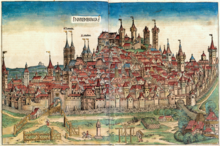Portal:Cities
The Cities Portal

A city is a human settlement of a notable size. The term "city" has different meanings around the world and in some places the settlement can be very small. Even where the term is limited to larger settlements, there is no universally agreed definition of the lower boundary for their size. In a more narrow sense, a city can be defined as a permanent and densely settled place with administratively defined boundaries whose members work primarily on non-agricultural tasks. Cities generally have extensive systems for housing, transportation, sanitation, utilities, land use, production of goods, and communication. Their density facilitates interaction between people, government organizations, and businesses, sometimes benefiting different parties in the process, such as improving the efficiency of goods and service distribution.
Historically, city dwellers have been a small proportion of humanity overall, but following two centuries of unprecedented and rapid urbanization, more than half of the world population now lives in cities, which has had profound consequences for global sustainability. Present-day cities usually form the core of larger metropolitan areas and urban areas—creating numerous commuters traveling toward city centres for employment, entertainment, and education. However, in a world of intensifying globalization, all cities are to varying degrees also connected globally beyond these regions. This increased influence means that cities also have significant influences on global issues, such as sustainable development, climate change, and global health. Because of these major influences on global issues, the international community has prioritized investment in sustainable cities through Sustainable Development Goal 11. Due to the efficiency of transportation and the smaller land consumption, dense cities hold the potential to have a smaller ecological footprint per inhabitant than more sparsely populated areas. Therefore, compact cities are often referred to as a crucial element in fighting climate change. However, this concentration can also have significant negative consequences, such as forming urban heat islands, concentrating pollution, and stressing water supplies and other resources. (Full article...)
Selected city -
Sarajevo (/ˌsærəˈjeɪvoʊ/ SARR-ə-YAY-voh; Cyrillic: Сарајево, pronounced [sǎrajeʋo] ; see names in other languages) is the capital and largest city of Bosnia and Herzegovina, with a population of 275,524 in its administrative limits. The Sarajevo metropolitan area including Sarajevo Canton, East Sarajevo and nearby municipalities is home to 555,210 inhabitants. Located within the greater Sarajevo valley of Bosnia, it is surrounded by the Dinaric Alps and situated along the Miljacka River in the heart of the Balkans, a region of Southern Europe.
Sarajevo is the political, financial, social, and cultural center of Bosnia and Herzegovina and a prominent center of culture in the Balkans. It exerts region-wide influence in entertainment, media, fashion, and the arts. Due to its long history of religious and cultural diversity, Sarajevo is sometimes called the "Jerusalem of Europe" or "Jerusalem of the Balkans". It is one of a few major European cities to have a mosque, Catholic church, Eastern Orthodox church, and synagogue within the same neighborhood. (Full article...)Did you know -
- ... that the 32-story Bridge Apartments in New York City were built directly above a 12-lane freeway?
- ... that 32 former members of the city council of Bogor, Indonesia, were convicted of corruption in 2010, including 3 who were still serving?
- ... that New York City's Hotel Knickerbocker closed after fourteen years of operation and did not reopen for nearly a century?
- ... that New York City's Mansfield Hotel was developed by two neighbors from Vermont, one of whom later served as Vermont's governor?
- ... that when part of New York City's Hotel Riverview became a theater, some people thought that the hotel's overflowing toilets and leaky ceilings were part of the show there?
- ... that Fane Lozman took Riviera Beach to the US Supreme Court once in 2013 for seizing his floating home and again in 2018 for arresting him, and won both times?
Related portals
Related WikiProjects
Manila (/məˈnɪlə/ mə-NIL-ə; Filipino: Maynila, pronounced [majˈnilaʔ]), officially the City of Manila (Filipino: Lungsod ng Maynila, [luŋˈsod nɐŋ majˈnilaʔ]), is the capital and second-most-populous city of the Philippines. Located on the eastern shore of Manila Bay on the island of Luzon, it is classified as a highly urbanized city. As of 2019, it is the world's most densely populated city proper. It was the first chartered city in the country, and was designated as such by the Philippine Commission Act No. 183 on July 31, 1901. It became autonomous with the passage of Republic Act No. 409, "The Revised Charter of the City of Manila", on June 18, 1949. Manila is considered to be part of the world's original set of global cities because its commercial networks were the first to extend across the Pacific Ocean and connect Asia with the Spanish Americas through the galleon trade; when this was accomplished, it was the first time an uninterrupted chain of trade routes circling the planet had been established.
By 1258, a Tagalog-fortified polity called Maynila existed on the site of modern Manila. On June 24, 1571, after the defeat of the polity's last indigenous Rajah Sulayman in the Battle of Bangkusay, Spanish conquistador Miguel López de Legazpi began constructing the walled fortification Intramuros on the ruins of an older settlement from whose name the Spanish-and-English name Manila derives. Manila was used as the capital of the captaincy general of the Spanish East Indies, which included the Marianas, Guam and other islands, and was controlled and administered for the Spanish crown by Mexico City in the Viceroyalty of New Spain. (Full article...)Selected article -

General images -
Topics
List articles
Subcategories
Associated Wikimedia
The following Wikimedia Foundation sister projects provide more on this subject:
-
Commons
Free media repository -
Wikibooks
Free textbooks and manuals -
Wikidata
Free knowledge base -
Wikinews
Free-content news -
Wikiquote
Collection of quotations -
Wikisource
Free-content library -
Wikiversity
Free learning tools -
Wiktionary
Dictionary and thesaurus









































